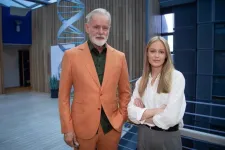(Press-News.org) PULLMAN, Wash. -- A new algorithm may make robots safer by making them more aware of human inattentiveness.
In computerized simulations of packaging and assembly lines where humans and robots work together, the algorithm developed to account for human carelessness improved safety by about a maximum of 80% and efficiency by about a maximum of 38% compared to existing methods.
The work is reported in IEEE Transactions on Systems Man and Cybernetics Systems.
“There are a large number of accidents that are happening every day due to carelessness – most of them, unfortunately, from human errors,” said lead author Mehdi Hosseinzadeh, assistant professor in Washington State University’s School of Mechanical and Materials Engineering. “Robots act as planned and follow the rules, but the humans often don’t follow the rules. That’s the most difficult and challenging problem.”
Robots working with people are increasingly common in many industries, where they often work together. Many industries require that humans and robots share a workspace, but repetitive and tedious work can make people lose their focus and make mistakes. Most computer programs help robots react when a mistake happens. Those algorithms might focus either on improving efficiency or safety, but they haven’t considered the changing behavior of the people they’re working with, said Hosseinzadeh.
As part of their effort to develop a plan for the robots, the researchers first worked to quantify human carelessness, looking at factors such as how often a human ignores or misses a safety alert.
“We defined the carelessness, and the robot observed the behavior of the human and tried to understand it,” he said. “The notion of carelessness level is something new. If we know which human is inattentive, we can do something about that.”
Once the robot identifies careless behavior, it is programmed to change how it interacts with the human acting that way, working to reduce the chance that the person might cause a workplace error or hurt themselves. So, for instance, the robot might change the way it manages its tasks to avoid getting in the human’s way. The robot continuously updates the carelessness level and any changes that it observes.
The researchers tested their plan with a computer simulation of a packaging line made up of four people and a robot. They also tested a simulated collaborative assembly line where two humans would work together with a robot.
“The core idea is to make the algorithm less sensitive to the behavior of careless humans,” said Hosseinzadeh. “Our results revealed that the proposed scheme has the capability of improving efficiency and safety.”
After conducting a computerized simulation, the researchers are planning to test their work in a laboratory with real robots and people—and eventually in field studies. They also want to quantify and account for other human traits that affect workplace productivity, such as human rationality or danger awareness.
The work was funded by the National Science Foundation. Co-authors on the study included Bruno Sinopoli and Aaron F. Bobick from Washington University, St. Louis.
END
Robot planning tool accounts for human carelessness
2024-08-15
ELSE PRESS RELEASES FROM THIS DATE:
deCODE genetics: Rare sequence variants, that associate with a high risk of Parkinson‘s Disease
2024-08-15
Scientists at deCODE genetics, a subsidiary of AMGEN, have discovered rare sequence variants, predicted to cause a loss of function of ITSN1, that are associated with a high risk of Parkinson‘s Disease. The findings also support less studied pathways involved in the pathogenesis of the disease.
The study, published today in npj Parkinson‘s Disease, used whole-genome sequence data from Iceland (deCODE genetics), the UK (UK Biobank), and the US (Accelerating Medicines Partnership Parkinson‘s ...
Cleaning up the aging brain: Scientists restore brain's trash disposal system
2024-08-15
Alzheimer’s, Parkinson’s, and other neurological disorders can be seen as “dirty brain” diseases, where the brain struggles to clear out harmful waste. Aging is a key risk factor because, as we grow older, our brain's ability to remove toxic buildup slows down. However, new research in mice demonstrates that it’s possible to reverse age-related effects and restore the brain’s waste-clearing process.
“This research shows that restoring cervical lymph vessel function can substantially rescue the slower removal of waste from the brain associated with age,” said Douglas Kelley, PhD, a professor of Mechanical ...
Zebrafish use surprising strategy to regrow spinal cord
2024-08-15
Zebrafish are members of a rarefied group of vertebrates capable of fully healing a severed spinal cord. A clear understanding of how this regeneration takes place could provide clues toward strategies for healing spinal cord injuries in people. Such injuries can be devastating, causing permanent loss of sensation and movement.
A new study from Washington University School of Medicine in St. Louis maps out a detailed atlas of all the cells involved — and how they work together — in regenerating the zebrafish spinal cord. In an unexpected finding, the researchers showed that survival and adaptability of the severed neurons themselves is required for full spinal cord regeneration. ...
Bone fracture rates vary dramatically by race
2024-08-15
A new paper in the Journal of Bone and Mineral Research, published by Oxford University Press, finds that bone fracture rates in older women differ by race, quite significantly. While researchers have known for years that the risk of bone fracture is highest for White women, this is the first study to show the real fracture rate for Asian and Hispanic women.
Until recently researchers have had limited data on fracture rates by specific race and ethnicity beyond White people, and even less fracture data within race and ethnic groups. Hispanic and Asian populations are the ...
2024 Shanghai Ranking: Hebrew University rises to 81st, showcasing academic excellence
2024-08-15
For the second consecutive year, three Israeli universities are ranked among the top 100 institutions globally. Alongside the Hebrew University, ranked 81st, are the Technion (85th) and the Weizmann Institute (69th). This is an outstanding achievement for Israeli academia and especially for the Hebrew University.
Professor Asher Cohen, President of the Hebrew University, stated: "The presence of three Israeli universities in the list of the top 100 universities globally is an exceptional achievement in such a challenging and complex year. The Hebrew University's rise to 81st place ...
Neoadjuvant immunotherapy may facilitate surgery and improve outcomes for patients with high-risk liver cancer
2024-08-15
Bottom Line: Patients with liver cancer who received immune checkpoint inhibitors (ICIs) before surgery—including those who would not have been eligible for surgery by conventional criteria—had similar outcomes to patients who received surgery upfront, according to results from a retrospective study.
Journal in Which the Study was Published: Cancer Research Communications, a journal of the American Association for Cancer Research (AACR)
Author: Mari Nakazawa, MD, first author of the study and a clinical research fellow ...
Racial, economic barriers hinder access to medicine for treating opioid use disorder
2024-08-15
PORTLAND, Ore. – Patients with a prescription for an opioid use disorder medication may have a tough time getting it filled if their pharmacy is in a community that’s racially and economically segregated, according to a new study led by scientists at Oregon State University and Johns Hopkins University.
The findings shed additional light on inequities in health care as the U.S.’s overdose crisis continues to accelerate, with fatality rates rising fastest in Black and Hispanic/Latinx communities.
“While there have been notable policy changes over the past decade that ...
Weather and geography drive waterborne infectious disease outbreaks
2024-08-15
An analysis of 12 years of data collected from over 500 hospitals in 25 different U.S. states shows that weather, geographic location, and urban or rural location all appear to influence hospitalizations for waterborne infectious diseases, according to a new study by researchers at Columbia University in the open-access journal PLOS Water.
Waterborne infectious diseases caused by bacteria, parasites, and viruses still affect over 7,000,000 people annually in the United States despite drinking and recreational water regulations, and sanitation ...
First-of-its-kind vaccine expands malaria protection for pregnant women
2024-08-15
August 14, 2024 – In a report published in The Lancet Infectious Diseases (Safety and efficacy of PfSPZ Vaccine against malaria in healthy adults and women anticipating pregnancy in Mali: two randomised, double-blind, placebo-controlled, phase 1 and 2 trials) a team led by investigators at the Malaria Research and Training Center (MRTC), Bamako, Mali; the Laboratory of Malaria Immunology and Vaccinology (LMIV), National Institute of Allergy and Infectious Diseases, National Institutes of Health; and Sanaria Inc. describes ...
Candidate malaria vaccine provides lasting protection in NIH-sponsored trials
2024-08-15
WHAT:
Two National Institutes of Health (NIH)-supported trials of an experimental malaria vaccine in healthy Malian adults found that all three tested regimens were safe. One of the trials enrolled 300 healthy women ages 18 to 38 years who anticipated becoming pregnant soon after immunization. That trial began with drug treatment to remove malaria parasites, followed by three injections spaced over a month of either saline placebo or the investigational vaccine at one of two dosages. Both dosages of the vaccine candidate conferred a significant degree of protection from parasite infection and clinical malaria that was sustained ...



